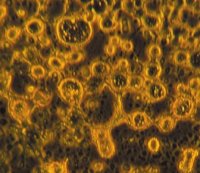Life’s Housing May Come from Space
Ron Cowen
Gimme shelter! The cell-like envelopes in which life
on Earth arose and evolved may literally have dropped
from the sky, a new study suggests.
 |
|
These droplets—residues of
organic ices exposed to ultraviolet light and then
mixed with water—have structures similar to cell
membranes.
Dworkin
et al./PNAS |
Scientists exploring the origins of life have focused
on two ingredients—proteins, the workhouse molecules
that underlie life's activities, and DNA, the molecule
that carries the blueprint for future generations. But
to thrive, life as we know it requires something else: a
container to protect the molecular machinery from the
vagaries of the world around it.
Icy materials present in gas clouds throughout our
galaxy could have provided this shelter, according to
researchers from NASA's Ames Research Center, SETI
(Search for Extraterrestrial Intelligence) Institute in
Mountain View, Calif., and the University of California,
Santa Cruz. The materials could have hitched a ride to
Earth on comets, meteorites, or interplanetary dust.
In their lab, the scientists prepared wafers of a
frozen mix containing water, methanol, ammonia, carbon
monoxide, and other molecules known to be present in
interstellar gas clouds. They then subjected the wafers
to the frigid temperatures and high vacuum present in
deep space. Next, they zapped the ices with ultraviolet
light for several weeks, mimicking the high-energy
radiation that these molecules would receive in space.
The researchers brought the residue of this icy
mixture to room temperature and added liquid water,
which would have been present on ancient Earth. They
found that the resulting molecules had arranged
themselves in spherical vesicles similar in size, shape,
and structure to cell membranes.
"At some point, life had to become encapsulated. It
had to separate itself from its environment," says
biochemist Jason P. Dworkin of both Ames and SETI. "If
this stuff is raining down from space . . . then early
life may have had no problem in forming a shell around
itself."
Dworkin, David W. Deamer of UC Santa Cruz, and Scott
A. Sandford and Louis J. Allamandola of Ames describe
their findings in the Jan. 30 Proceedings of the
National Academy of Sciences.
Deamer reported in 1989 that when organic compounds
extracted from the so-called Murchison meteorite
interact with water, they form hollow droplets that
resemble cell membranes. When he and his colleagues
analyzed laboratory ices, "to our surprise and delight,
we found that vesicular structures formed that looked
very much like those we saw in the Murchison material,"
Deamer says.
Also, the vesicles absorb ultraviolet light and
convert the energy into visible light. This is akin to
the way living cells harvest energy, says Allamandola.
The researchers have "been able to simulate the
formation of these vesicles . . . using a pretty simple
and completely plausible initial mix of molecules that
should be present throughout the interstellar medium,"
comments SETI astrobiologist Christopher F. Chyba. "The
sort of vesicles that encapsulate life on Earth [could]
be everywhere throughout the galaxy."
Other teams had previously shown that interstellar
ices contain compounds that could be precursors for
life. Chyba says it's even more startling to find that
such ices are making structures "that really look like a
cell membrane."

References:
Dworkin, J.P., et al. 2001.
Self-assembling amphiphilic molecules: Synthesis in
simulated interstellar/precometary ices. Proceedings
of the National Academy of Sciences 98(Jan. 30):815.
Sources:
Louis J.
Allamandola
Astrochemistry Laboratory
National
Aeronautics and Space Administration
Ames Research
Center
Mail Stop 245-6
Moffett Field, CA
94035-1000
David W. Deamer
Department of
Chemistry and Biochemistry
University of California,
Santa Cruz
Santa Cruz, CA 95064
Jason P. Dworkin
Astrochemistry
Laboratory
National Aeronautics and Space
Administration
Ames Research Center
Mail Stop
245-6
Moffett Field, CA 94035-1000
Scott A. Sandford
Astrochemistry
Laboratory
National Aeronautics and Space
Administration
Ames Research Center
Mail Stop
245-6
Moffett Field, CA 94035-1000
|